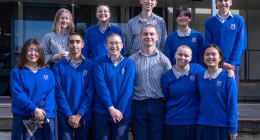Do you still find yourself struggling to manage your time effectively? With so many tasks to complete and distractions around us, it’s easy to feel overwhelmed and lose focus. Fortunately, there are several techniques and strategies that can help you boost productivity and help you accomplish your goals. The principles discussed in the article can be applied to academics, extracurriculars, or even life in general.
1. Collect your tasks
How many times has a task popped up in your head, only for it to be forgotten and then delayed until the last moment or even completely ignored until the deadline has already passed?
To mitigate this problem, consider writing down all the tasks that pop up in your head on a piece of paper, notebook or any device. Productivity Consultant David Allen once said, “Your mind is for having ideas, not holding them”, so collecting everything in your head will provide a clear vision of your daily agenda including all that needs to be done. In doing so, you will prevent yourself from forgetting to do something, thus, allowing you to spend your time consciously as you stay aware of all the tasks you must complete.
2. Prioritise your tasks – Eat That Frog!
“If it’s your job to eat a frog, it’s best to do it first thing in the morning. And if it’s your job to eat two frogs, it’s best to eat the biggest one first.” – Mark Twain
We can all learn a little from Mark Twain’s quote above. Not the eating the frog part, but how his analogy relates to time management. The frog Twain talks about essentially refers to the hardest or most important task that you have to do during the day. If you start off your day by completing that task, then you will have the satisfaction of knowing that you’ve gotten the most painful thing out of the way for the rest of the day.
Now if you have two, three, or even seventeen frogs, you have to determine which one to eat first, and that is when prioritisation comes into play. You should create a general framework for the categorisation of your tasks, including “do it now” and “do it later”. A general popular framework is to classify tasks that take less than 5 minutes into the “do it now box” and the rest into the “do it later” box, ranking them further from most important to least important based on energy and time required, as well as the consequences of not completing every task. This will allow you to recognise which frogs are the biggest, allowing you to eat them one by one with increasing ease.
Note: No frogs were harmed in the making of this article
3. Make a schedule
After you have successfully collected all your ideas and prioritised them, it’s time to make a plan on how to tackle these challenges. It’s no good to just write down an entire list of all the tasks that you must do. To ensure that you stay on top of all that has been set out, create blocks of time throughout the day in which you will work on certain tasks, which can be done on pen and paper or even a digital platform.
The schedule that you create for yourself should be flexible, such that any new tasks you receive during the day can be added to your schedule while pre-existing tasks can be adjusted to different blocks of time.
The blocks of time you allocate to yourself should also be realistic. Can you really complete that entire differentiation exercise in 30 minutes? Or that novel study essay in 45 minutes? If possible, do try to make an effort to time yourself so you know how long you really take to complete your tasks as opposed to estimating. Accurate time blocks can also create significant morale boosts during the day as you complete tasks and keep up or even stay ahead of the schedule.
After your schedule is all written out, enjoy the satisfaction of seeing them get crossed off one by one until all your tasks are complete!
4. Use the Pomodoro Technique
It’s time for the execution part of getting your tasks done. The Pomodoro Technique is a classic favourite productivity hack for all who aspire to better manage their time. Originally invented in the early 1990s by Francesco Cirillo, the Pomodoro Technique is a method of time-blocking that originally involved 25-minute intervals of focused work followed by making note of where you left off before taking a 5-minute break. Every 4 intervals of focused work, take a longer break, for around 15 to 20 minutes.
The intervals of focused work create an incentive for users to race against the clock, allowing them to stay laser-focused on their tasks for a chunk of time and be efficient, while also fighting distractions and allowing for frequent rest.
It is also worth noting that the Pomodoro Technique does not have to strictly be bounded by the intervals that Francesco Cirillo used himself – Taylor the Pomodoro Technique to your liking!
5. Condition the mind to boredom
Nowadays, almost everyone is a world champion in the art of escaping boredom with such ease of access to the entire internet at their fingertips. With highly-distractive forms of entertainment like YouTube, Tik Tok or Instagram reels, it has become far too easy to waste hours on social media, especially when the tasks at hand, such as homework or studying, do not appeal to us.
So how do we stay on task so that we can remain efficient in the face of boredom? Rather than giving in to the urge and pulling out the phone, consider embracing boredom instead. When boredom, like letting your mind wander, sitting in silence, or staring at a wall becomes comfortable to do, it no longer feels like a chore. Suddenly, completing your tasks doesn’t seem so bad after all, and you start having control over your desire to use social media as your mind realises that you don’t need this constant stimulation. As this happens, you become less prone to distractions when you’re working, saving so much time that is usually built up from scrolling through the endless pits of social media, allowing for efficiency in time management.
June 4th, 2023
Aaron Huang








